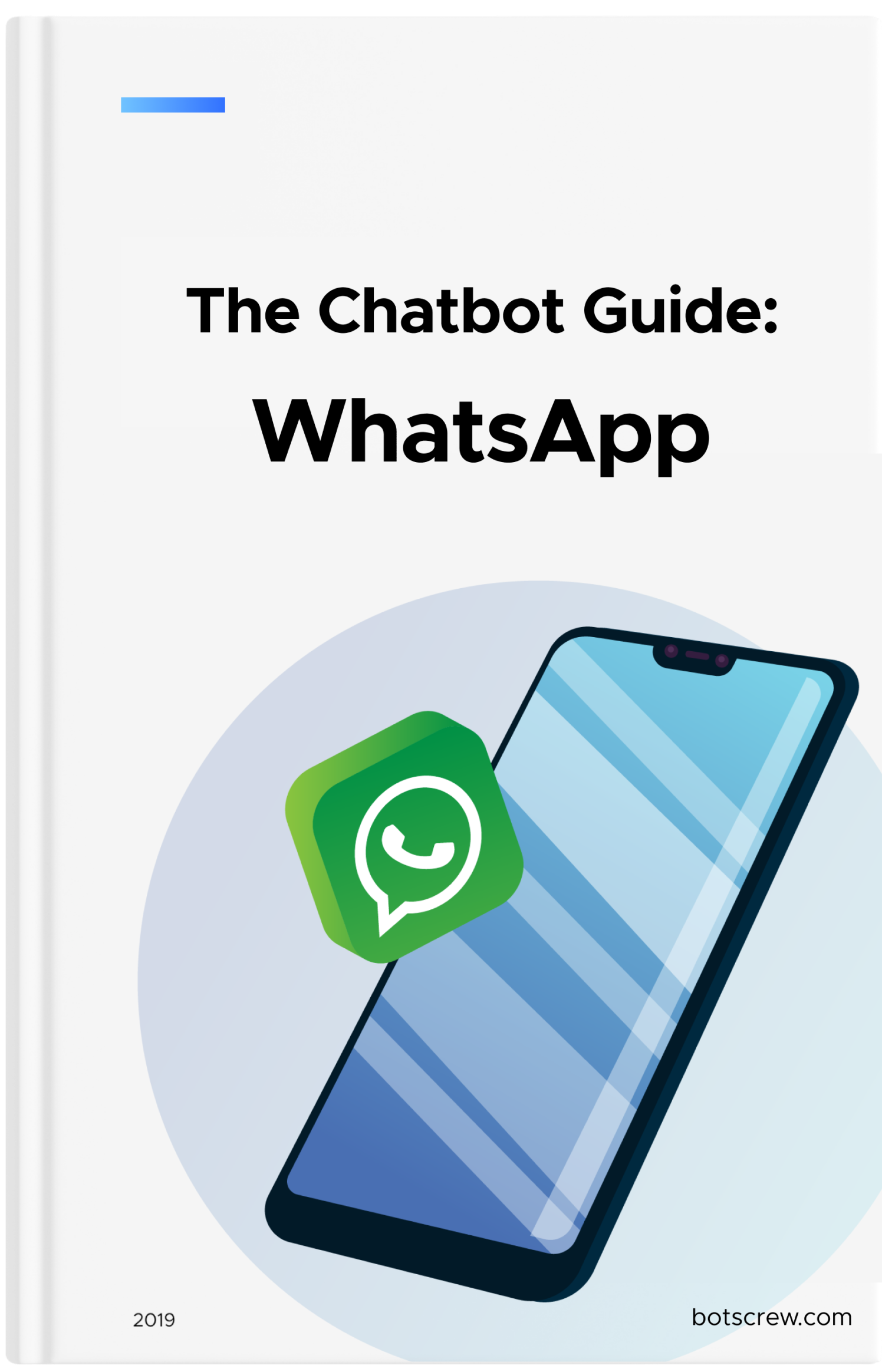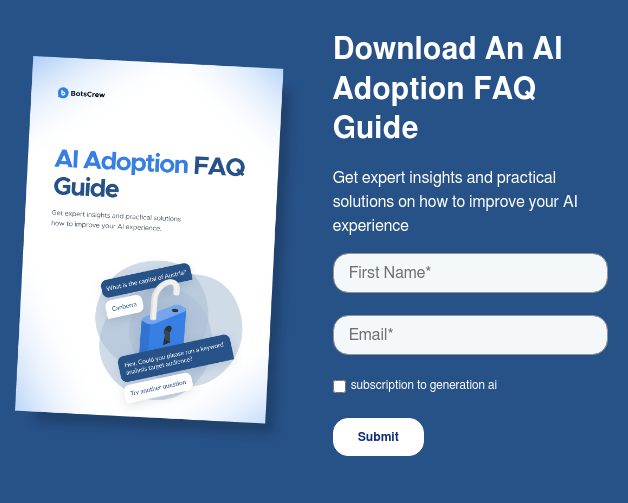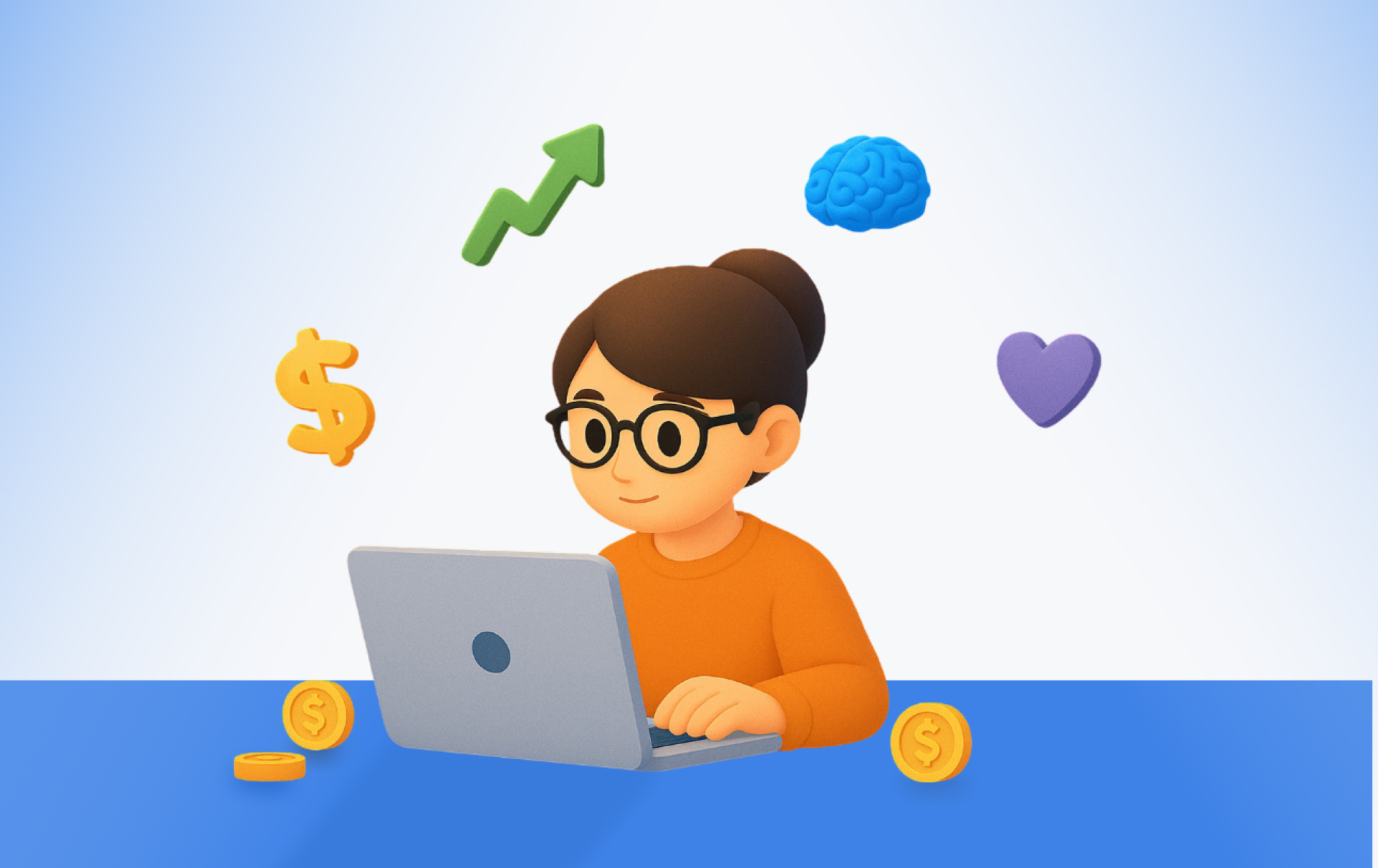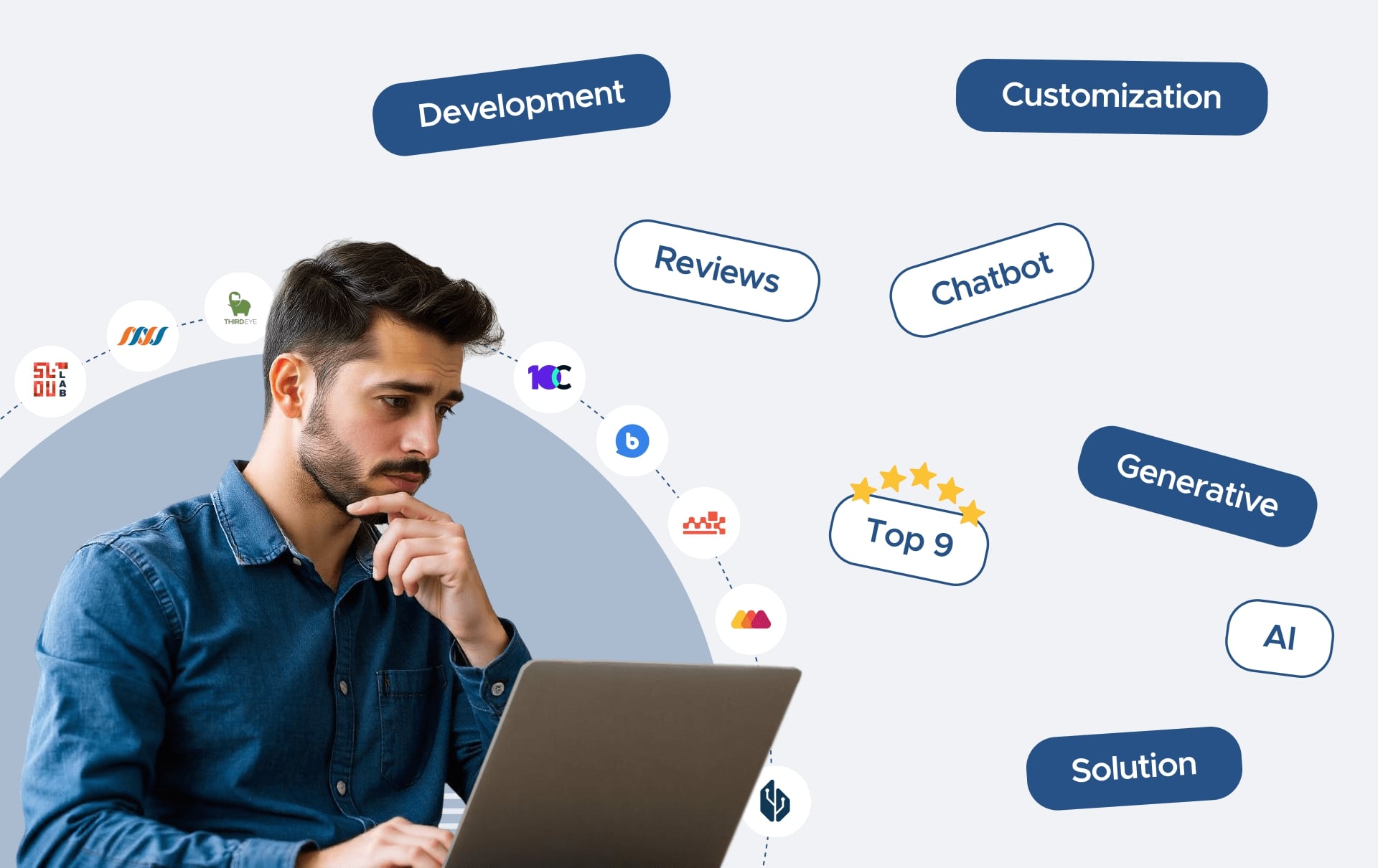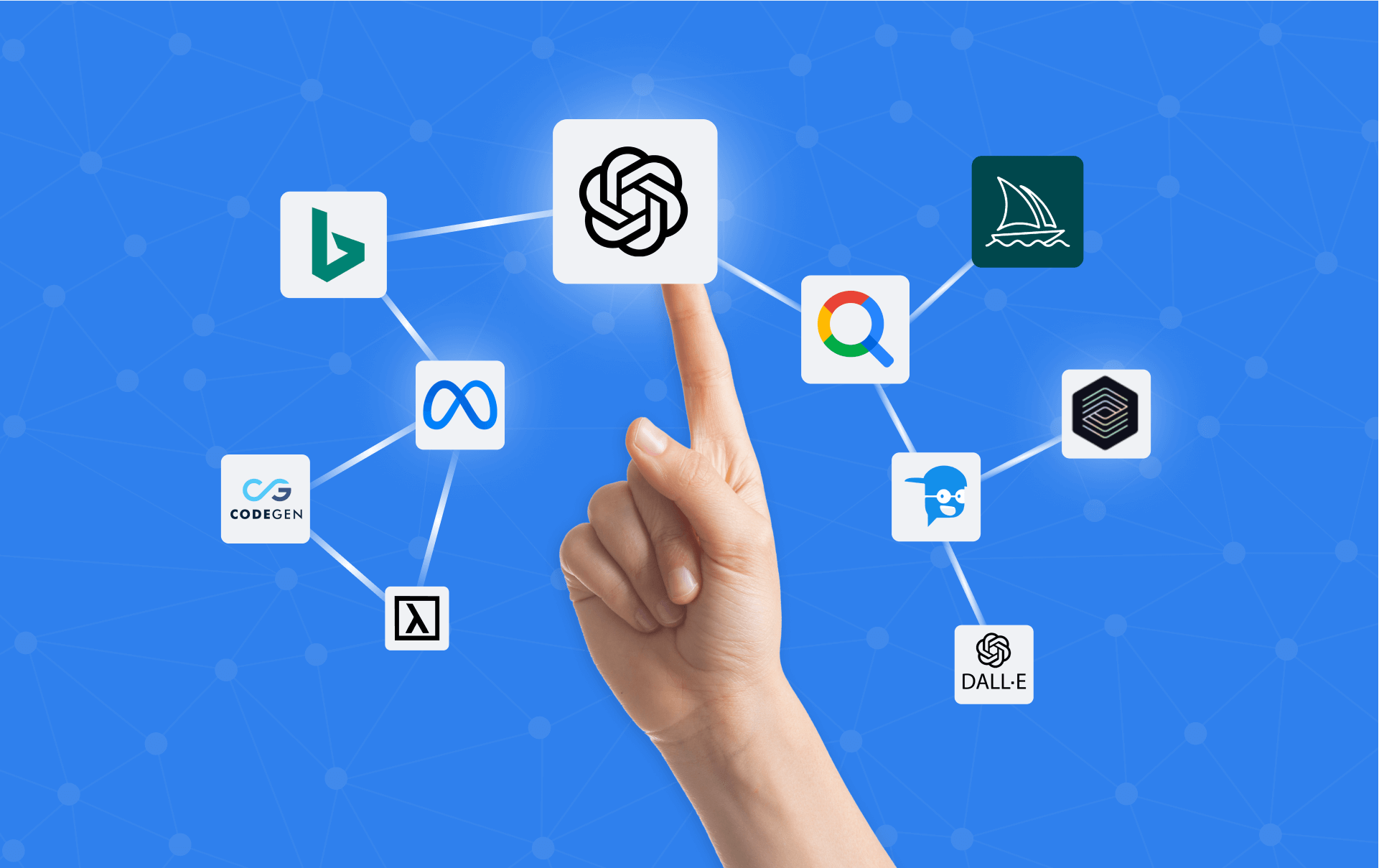Custom AI Development vs. Off-the-Shelf AI: A Guide for Strategic Decision-Makers
As AI adoption accelerates, business leaders face a critical decision: invest in custom AI development or opt for off-the-shelf AI solutions. This article provides a comprehensive comparison to help executives choose the right approach based on cost, scalability, performance, and strategic fit.
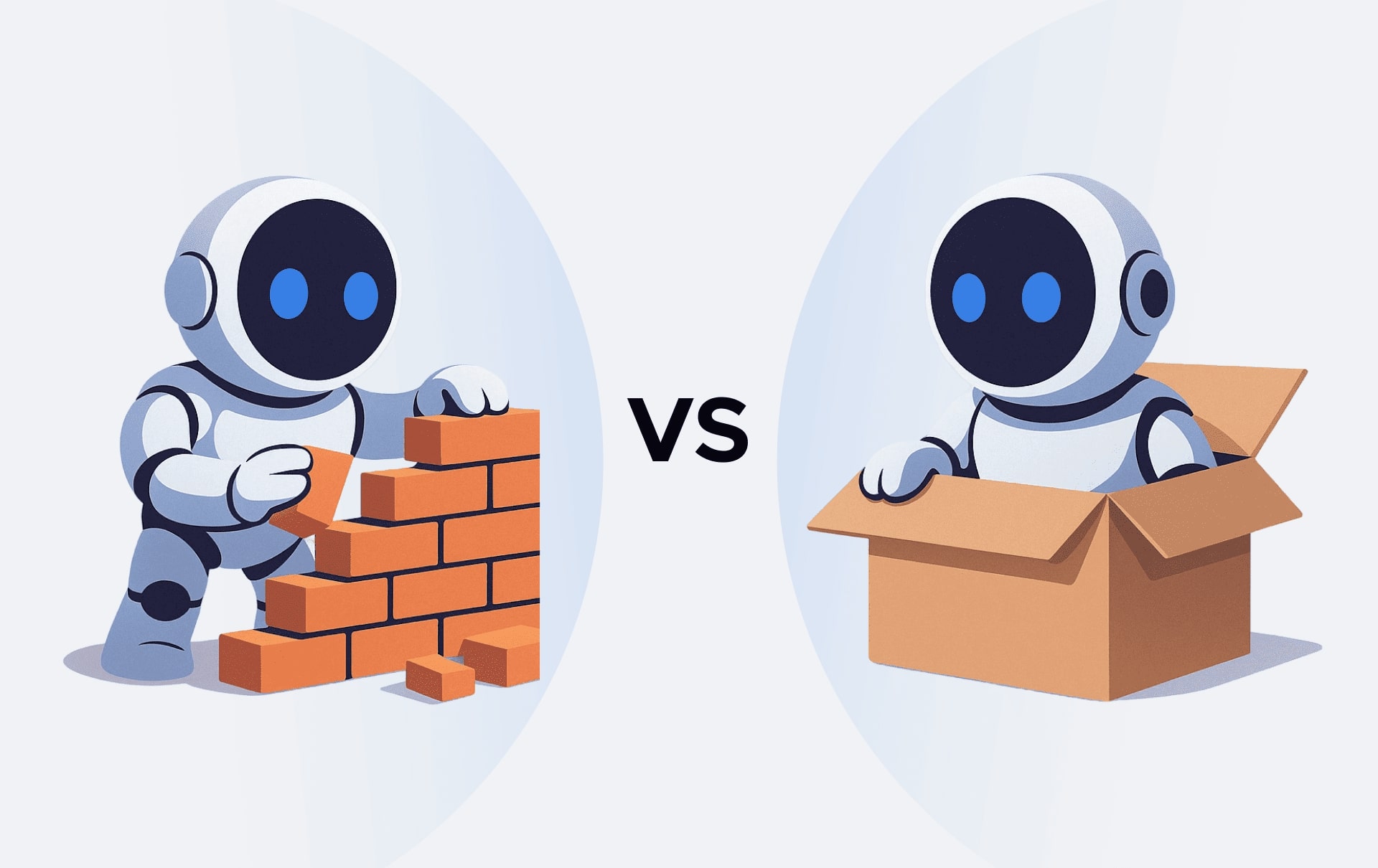
- Introduction
- What Are Off-the-Shelf AI Solutions?
- What Is Custom AI Development?
- Off-the-shelf AI vs. Custom AI development
- Cost Considerations and ROI
- Time-to-Market and Deployment Speed
- Scalability and Flexibility
- Integration with Systems and Data Control
- Ownership, Intellectual Property, and Vendor Lock-In
- Summing up
- Off-the-Shelf AI Solutions Pros & Cons:
- Custom AI Development Pros & Cons:
- Conclusion and Decision-Making Framework
- Final Advice
Artificial Intelligence (AI) adoption is increasingly vital for businesses aiming to stay ahead in today’s competitive landscape. Recent studies show that 78% of organizations now use AI in at least one business function, up from 55% a year ago. Yet, business leaders and technology executives often face a critical strategic decision: Should they purchase ready-made, off-the-shelf AI solutions, or invest in custom AI development tailored precisely to their organization's needs? Each approach carries distinct implications for cost, deployment speed, capabilities, and competitive advantage. This article explores these key considerations, helping businesses make informed decisions to significantly enhance their innovation potential and maximize return on investment (ROI).

What Are Off-the-Shelf AI Solutions?
Off-the-shelf AI refers to pre-built, general-purpose AI tools and services readily available for immediate use. Examples include chatbot templates, automated customer support systems, pre-trained image and voice recognition models, sentiment analysis tools, and ready-to-use AI integrations for popular software like Salesforce or HubSpot. Providers such as Google, Microsoft, Amazon, and IBM offer cloud-based APIs and platforms that businesses can easily plug into their existing infrastructure.
The primary advantages of off-the-shelf solutions include rapid deployment, tested reliability, and a lower upfront investment. They are ideal for organizations looking for quick wins or those with budget constraints who need immediate access to AI capabilities without extensive internal technical expertise.
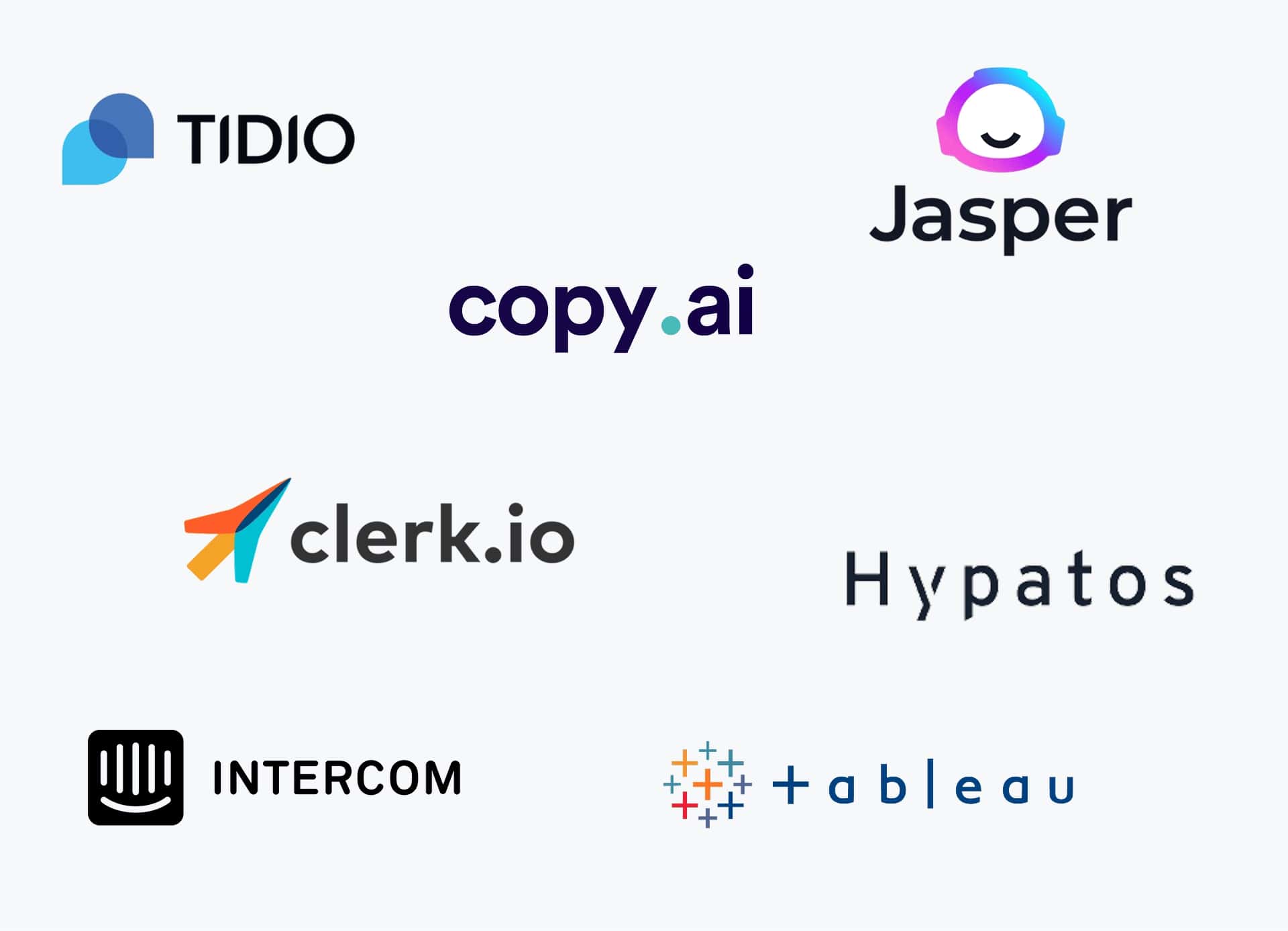
Examples of Off-Shelf AI
What Is Custom AI Development?
Custom AI development involves creating AI systems specifically designed around an organization's unique needs and processes. It usually requires a dedicated team of data scientists and engineers, leveraging proprietary data to craft a highly specialized solution. Though initially more expensive and time-consuming, custom AI can precisely match a business's specific requirements, creating potential competitive advantages and intellectual property (IP) ownership.
Off-the-shelf AI vs. Custom AI development
When considering AI implementation, organizations face a fundamental strategic decision: Should they choose off-the-shelf AI solutions or invest in custom AI development?
To make an informed choice, leaders must evaluate multiple critical factors, including cost considerations and return on investment (ROI), time-to-market and deployment speed, scalability and flexibility, integration capabilities, data control, performance customization, ongoing maintenance, and intellectual property ownership. This section provides a comprehensive comparison of these key areas, empowering businesses to select the approach best aligned with their operational requirements and strategic ambitions.
Cost Considerations and ROI
Off-the-Shelf Cost:
Off-the-shelf AI solutions are generally attractive due to their lower initial investment. Businesses typically pay a subscription or licensing fee, avoiding substantial upfront expenditures on hiring specialized AI developers and building the required infrastructure. This approach is particularly beneficial for companies with limited budgets or those aiming for immediate results. However, it's essential to consider ongoing operational expenses—many providers charge per use or require monthly subscription fees. These recurring costs can accumulate significantly, especially as the business expands its use of the AI service.
Custom AI Cost:
Custom AI development, while initially more costly, involves hiring skilled data scientists, machine learning engineers, and investing in substantial computing resources to train AI models. Although the upfront investment is significant, custom AI provides clear long-term financial advantages by eliminating ongoing vendor fees. Moreover, it allows organizations to control maintenance expenses directly. Custom AI can also deliver considerable ROI by generating new revenue streams or efficiency improvements unique to the business. Additionally, owning the intellectual property of custom-developed AI solutions offers potential monetization opportunities, further boosting ROI.
Businesses should evaluate total cost of ownership (TCO)—weighing initial versus ongoing costs, alongside the long-term value the AI generates.
Read: Want a deeper look at AI ROI? Check out our article on the complexities of measuring real business value from generative AI.
Time-to-Market and Deployment Speed
Off-the-Shelf Speed:
One of the strongest advantages of off-the-shelf AI solutions is their rapid deployment. These pre-built solutions can often be configured and implemented in just a matter of days or weeks.
For instance, integrating a pre-trained image recognition API into an application might only require minimal setup and testing, providing a quick path to operational capability. This plug-and-play approach is ideal for businesses needing swift implementation or those experimenting with AI without substantial lead time.
Custom AI Speed:
Custom AI solutions, in contrast, require a more extended development process. Developing an AI model from scratch involves data collection, algorithm experimentation, model training, and extensive testing, which can span several months. For example, building a custom recommendation engine involves gathering and preparing historical user data, training algorithms, and integrating these into the existing infrastructure, which significantly extends time-to-market. However, leveraging existing open-source frameworks can somewhat accelerate this process, creating a hybrid approach—but it remains slower compared to off-the-shelf solutions.
So, off-the-shelf offers speed, whereas custom demands patience but results in a tailored fit.

Scalability and Flexibility
Off-the-Shelf Scalability and Flexibility
Off-the-shelf AI solutions offer moderate scalability, suitable for general use cases. Vendors typically manage infrastructure and capacity, allowing businesses to scale their AI usage within predefined limits. However, if business requirements evolve beyond the solution's intended capabilities, limitations can emerge. Flexibility is restricted to basic configuration options, often leaving businesses dependent on vendor timelines for new features or updates.
Custom AI Scalability and Flexibility
Custom AI solutions are explicitly designed with scalability in mind, accommodating specific growth projections, data volumes, and user demands. They offer significant flexibility, enabling businesses to adapt functionalities swiftly as new requirements emerge, such as integrating additional data sources or enhancing algorithmic sophistication. Custom AI has the flexibility to adapt – you can update or extend the solution as your needs evolve. Need the model to consider a new input or perform a new type of analysis? Your team can modify the code or retrain the model with new data. This adaptability means custom AI can continue to fit like a glove even as the business changes.
The off-the-shelf tool is one-size-fits-many, so if your business’s needs expand beyond what the tool was designed for, you might hit limitations. For instance, you might want a new feature or an expanded capacity that the vendor doesn’t offer yet. In contrast, custom AI can be designed with your specific scalability requirements in mind. If you anticipate growth (more data, more users, new markets), you can architect the solution from the start to scale out on your own infrastructure or cloud. Custom systems can be expanded and optimized as needed, though requiring additional development effort to do so.
Integration with Systems and Data Control
Off-the-shelf integration and Data Control
Off-the-shelf AI solutions typically offer standard integration methods (APIs, plugins, etc.) that make it relatively straightforward to connect with your applications. This can simplify initial integration. However, there might be compatibility or depth limitations – you can only integrate in the ways the vendor allows. If your enterprise has complex legacy systems or unique workflows, a generic off-the-shelf tool might not mesh perfectly, potentially causing siloed systems or requiring you to adjust your processes to fit the tool.
Data control and security are vendor-managed, which may introduce concerns around compliance and privacy. With an off-the-shelf solution, you often must send your data to the vendor’s cloud or use their managed service. That raises questions of data ownership, privacy, and compliance. Essentially, you are entrusting sensitive business or customer data to a third party. The vendor may have robust security, but you have limited control over how data is handled beyond the contract terms. In industries with strict data regulations (finance, healthcare, etc.), this can be a sticking point.
Custom AI Integration and Data Control
Custom AI solutions offer seamless and deep integration tailored specifically to an organization's existing technology infrastructure. A custom AI is developed within your environment (or with your specific architecture in mind), so it can be seamlessly integrated into existing platforms, databases, and software. You have the freedom to design the integration points. For example, a custom AI could be built directly into your ERP system’s workflow, whereas an off-the-shelf might only offer a file import/export integration. Custom development thus ensures deeper integration that aligns with your IT architecture and business processes, which can result in smoother operations and less manual intervention.
A custom AI system can be built so that all data stays within your own controlled environments. You decide how data is stored, processed, and protected. Custom solutions allow implementing security measures tailored to your needs (e.g., specific encryption standards, on-premise processing to meet data sovereignty laws). Also, with custom AI, you maintain complete data ownership – no sharing with vendors or complying with their terms.
Custom AI gives the business full security control (and responsibility), whereas off-the-shelf provides generic security, and you must trust the provider. If data control, privacy, and seamless integration into a complex IT ecosystem are top priorities, custom AI has clear advantages. If using an off-the-shelf service, executives should perform due diligence on the vendor’s data policies and ensure they align with the company’s compliance requirements.
Concerned about data privacy or legacy system compatibility? Book a call with our CTO to discover how AI can fit your infrastructure 🚀
Performance and Customization of AI Capabilities
Off-the-Shelf Performance and Customization
Off-the-shelf solutions provide a strong baseline performance for common tasks, leveraging broadly trained AI models. However, their effectiveness can diminish significantly when addressing highly specialized or niche scenarios. Customization is generally limited, restricting the ability to refine AI outputs or incorporate unique business logic.
For example, a commercial image recognition API will have been trained on massive datasets to identify common objects with high accuracy. That means for common tasks, off-the-shelf can offer excellent performance out-of-the-box – likely better than what a small team could achieve in a short time. However, these models are generalized. When faced with a very domain-specific problem or data, their performance may lag. (E.g., a generic language AI might not understand industry-specific jargon as well as a model fine-tuned on that jargon.)
Off-the-shelf solutions come with a predetermined set of features and algorithms. If your needs fall outside those features, you might not get the results you want.
Custom AI Performance and Customization
Custom AI excels in delivering optimal performance tailored precisely to an organization’s unique challenges, using proprietary data and specialized models. By training on your proprietary data (say, your unique customer behavior patterns or specialized images), a custom model can potentially outperform any generic solution on that task. Essentially, custom AI can reach a higher ceiling of performance for your specific use case, whereas off-the-shelf offers high baseline performance for general cases but might hit a wall on specialized needs.
Custom AI allows for full customization of features and algorithmic approach. For instance, if you need a recommendation system that takes into account a very particular metric or business rule, a custom approach lets you incorporate that requirement. With off-the-shelf, you might have no way to add that nuance. Moreover, during custom development, you can iterate and fine-tune the model’s behavior with direct feedback from domain experts in your company, ensuring the AI’s output aligns with what’s practically useful. This level of tailoring (like adjusting a model to reduce certain types of errors that are critical to your business) is often not possible with a one-size-fits-all solution.
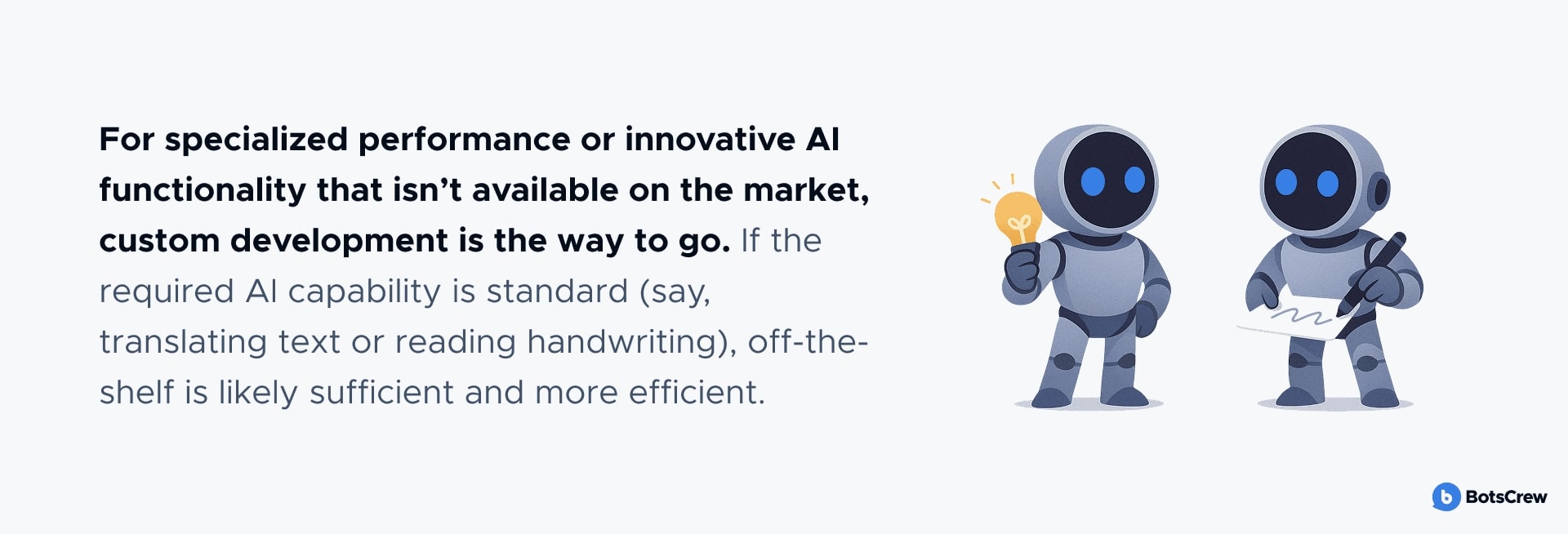
Maintenance and Support
Off-the-Shelf Maintenance and Support
Off-the-shelf solutions place maintenance responsibility primarily on vendors, reducing internal burdens but creating dependencies on vendor responsiveness and scheduled updates. The upside is you benefit from the vendor’s continued R&D and improvements without additional development costs. However, the downside of outsourced maintenance is a lack of control: you have to wait for the vendor’s update schedule and hope their support is responsive to your specific issues. If the AI isn’t performing well for your case, you have limited recourse besides providing feedback or switching solutions. Also, vendors might change their service terms or even discontinue a product, which can leave you in a lurch.
Custom AI Maintenance and Support
Custom AI solutions require organizations to maintain dedicated internal expertise or partnerships for ongoing support and maintenance. While demanding continuous investment, this approach ensures immediate issue resolution, tailored improvements, and complete autonomy over the development lifecycle.
With a custom AI solution, you’ll need a team (or an AI partner) to monitor the AI’s performance, update it as data drifts or new requirements emerge, and handle any technical issues. This means ongoing costs for support and development, whether via in-house staff or consultants. The advantage, however, is complete control over the update cycle and improvements. If you want to add a new feature or adjust the model, you can do so on your own timeline – you’re not waiting on a third-party’s roadmap. Furthermore, if a problem or bug is detected, your team can prioritize fixing it immediately (important for mission-critical applications), whereas with off-the-shelf you might wait for the vendor’s fix.
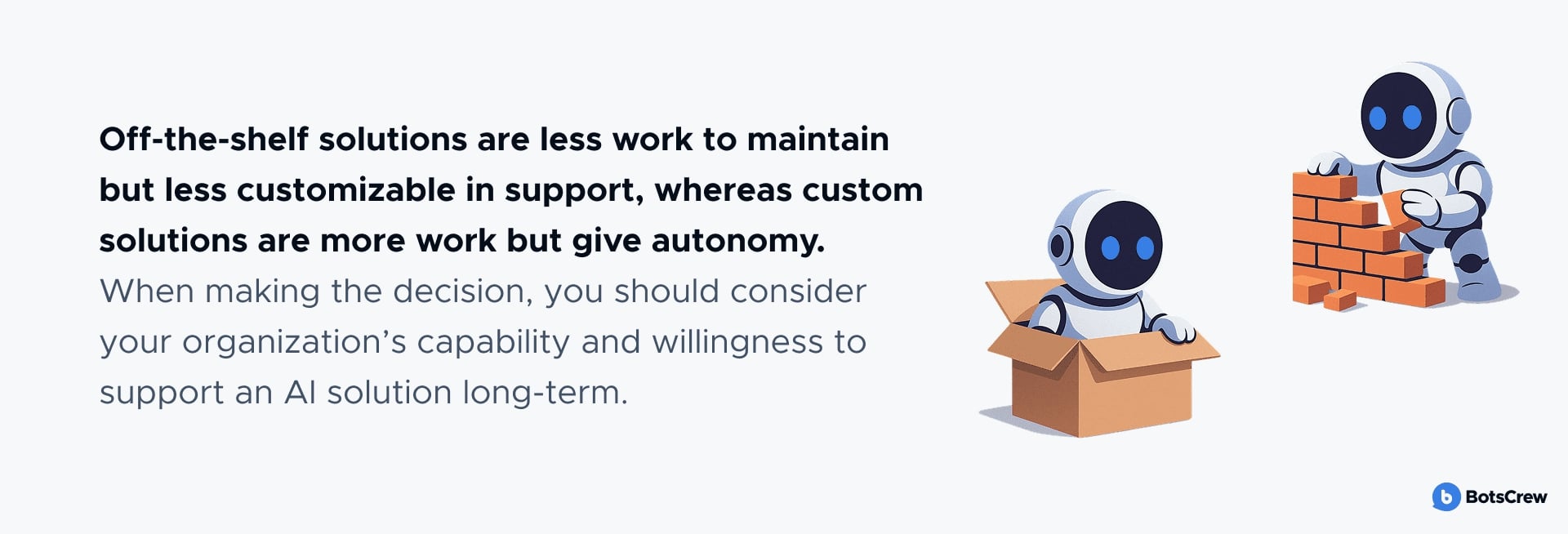
Ownership, Intellectual Property, and Vendor Lock-In
Off-the-Shelf Ownership and Vendor Lock-In
Off-the-shelf solutions entail licensing from vendors, resulting in limited control over intellectual property. This arrangement can lead to vendor lock-in, restricting flexibility to switch providers or evolve independently.
With off-the-shelf AI, the solution is proprietary to the vendor. You are essentially leasing or licensing the capability. This means no ownership of the underlying models or technology – if you stop paying, you lose access. Additionally, you may be locked in to the vendor’s ecosystem. If you’ve built business processes around a particular AI service, switching to another vendor or bringing the capability in-house later can be challenging (data portability issues, retraining staff, etc.).
There’s also a strategic consideration: if the AI is core to your business, relying on an external provider can be risky if that provider has outages or changes their service terms. Also, many businesses worry about differentiation: an off-the-shelf tool can be used by any competitor who also buys it, so it’s hard to get a unique advantage when the IP isn’t yours. However, off-the-shelf avoids the effort of reinventing the wheel for non-differentiating functions – sometimes it’s perfectly fine not to own the IP (for example, using a third-party AI for email spam filtering is fine for most companies, as that’s not core intellectual property for them).
Custom AI Ownership and Autonomy
When you build a custom AI, your organization owns the intellectual property of that solution – the model, the code, the data (assuming it’s all developed in-house or under contract that gives you ownership). This has several implications.
First, you have the freedom to use and even monetize that AI technology as you see fit – it could become a selling point or even a product in itself if you choose to offer it to others.
Second, owning the IP means you’re not tied to any external provider for this capability. There is no vendor lock-in – the continued use and development of the AI is under your control. You’re also immune to vendor pricing changes or policy shifts. For example, if you developed a custom AI for predictive maintenance, you could integrate it into all your operations without per-seat licensing costs, and even license it out if that aligns with your business model.
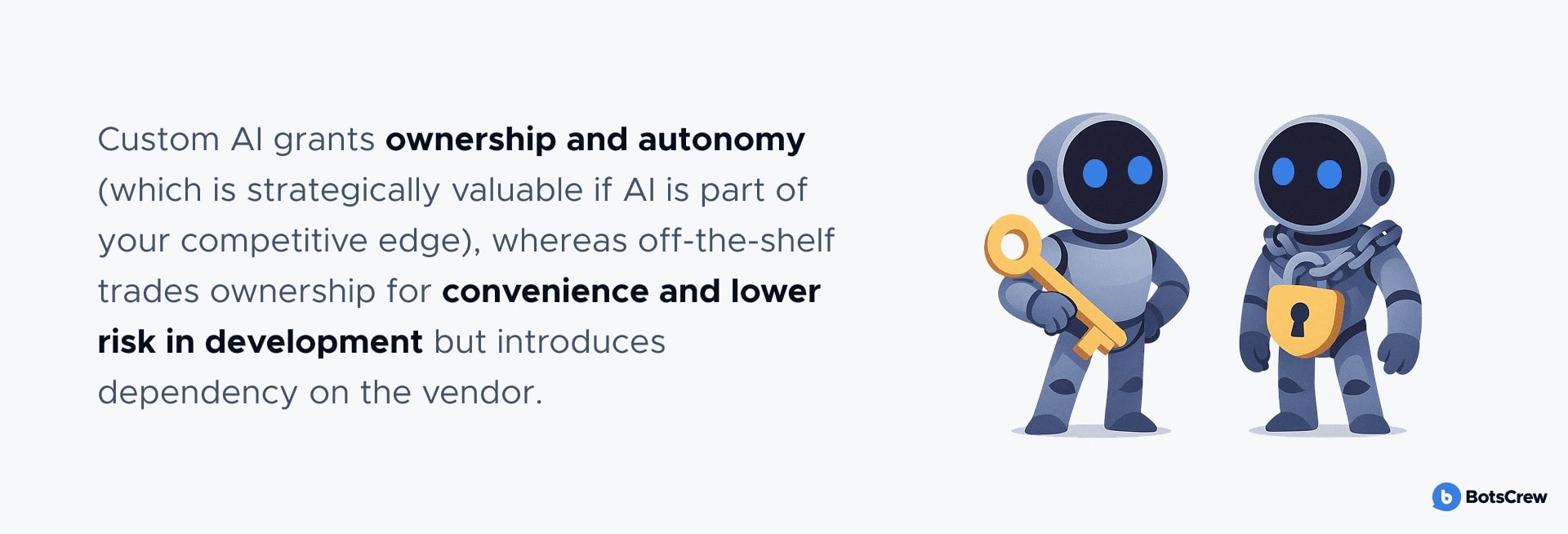
Summing up:
Off-the-Shelf AI Solutions Pros & Cons:
Pros:
- Rapid Deployment: Typically available within days or weeks, enabling businesses to swiftly enhance operational capabilities.
- Cost Efficiency: Lower initial investment and predictable subscription or usage-based pricing models make it attractive for budget-conscious organizations.
- Reliability and Expertise: Built and refined by specialized vendors, these solutions benefit from rigorous testing and wide user validation.
- Ease of Implementation: Minimal technical know-how is required, ideal for companies with limited in-house expertise.
Cons:
- Limited Customization: Off-the-shelf solutions offer restricted flexibility, making them potentially inadequate for unique business needs.
- Scalability Constraints: As businesses evolve, the fixed functionalities may not support expanding or changing requirements.
- Data Security and Control: Reliance on third-party providers involves risks related to data security, compliance, and vendor data handling policies.
- Vendor Dependency: Businesses can face vendor lock-in issues, limiting control over updates, changes in functionality, or discontinuation of services.
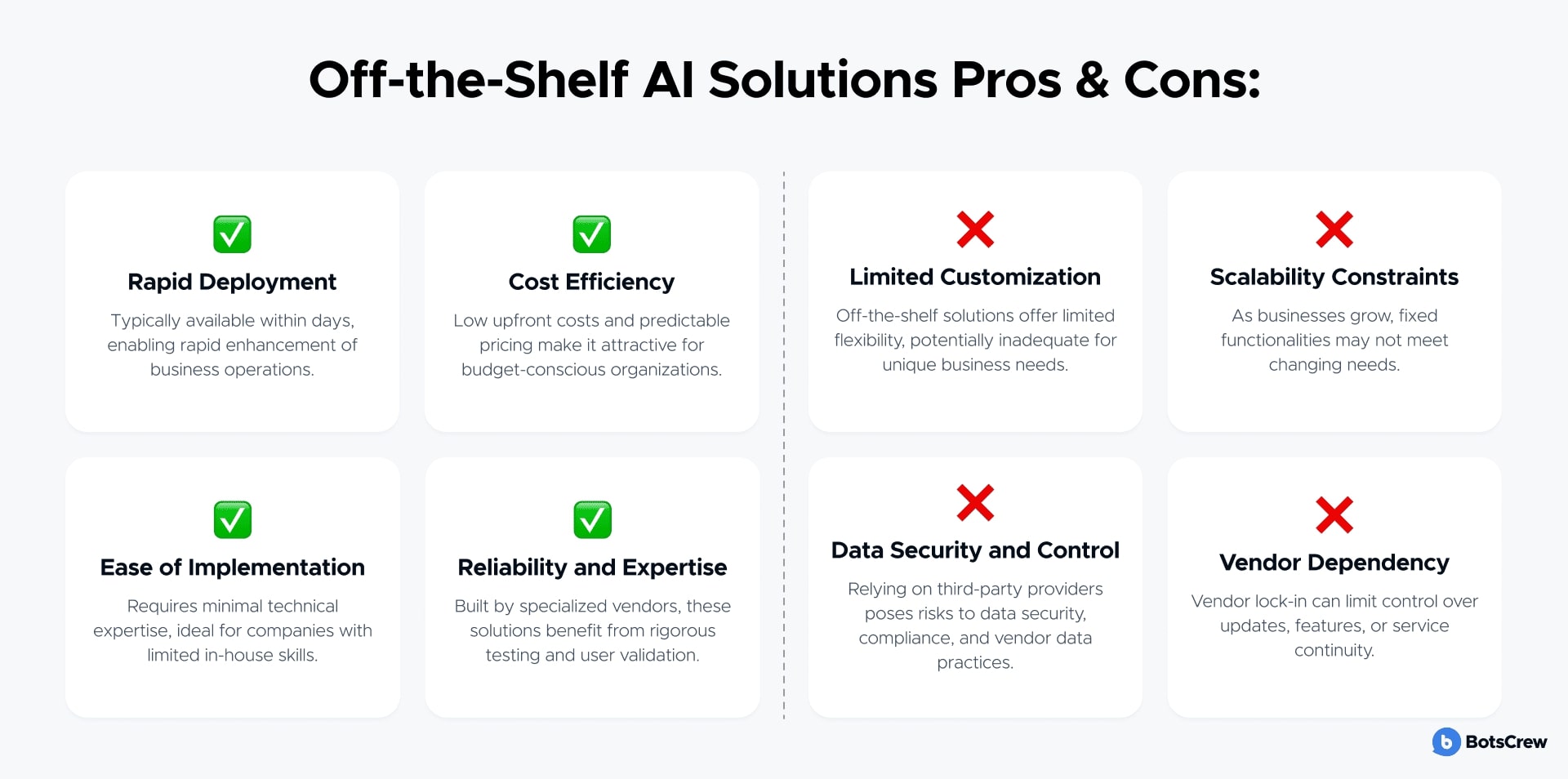
Custom AI Development Pros & Cons:
Pros:
- Highly Tailored Solutions: Specifically developed to meet exact business needs, ensuring optimal relevance and effectiveness.
- Superior Performance for Specialized Tasks: Built using proprietary data, delivering greater accuracy and better outcomes for specific scenarios.
- Complete Data Control and Compliance: Organizations maintain full authority over their data, essential for sensitive industries with stringent compliance requirements.
- Ownership of Intellectual Property: Provides strategic advantages by enabling businesses to leverage AI capabilities uniquely and potentially monetize innovations.
Cons:
- Higher Initial Investment: Requires substantial financial resources for development, skilled personnel, and infrastructure.
- Extended Development Time: Longer timelines from inception to deployment compared to ready-made solutions.
- Ongoing Maintenance Costs: Continuous investment is necessary to maintain, update, and optimize AI solutions.
- Requires Specialized Expertise: Organizations need dedicated teams or trusted partnerships to manage the complexity and evolution of AI systems.
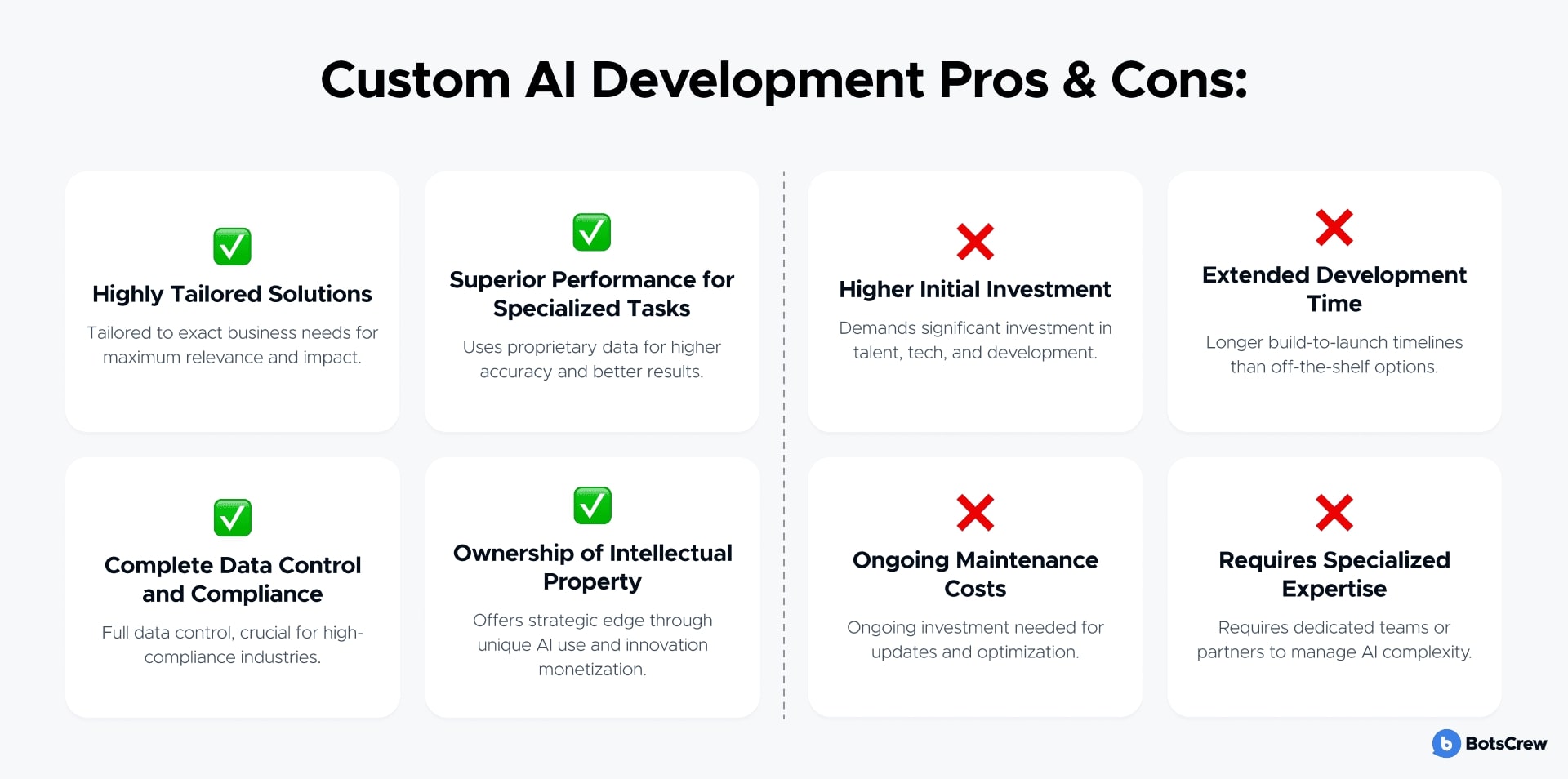
Still unsure which AI approach fits your organization best? Schedule a free strategy session with our team to explore the right path for your goals.
Conclusion and Decision-Making Framework
Neither option is universally better—it truly depends on the organization’s specific needs, strategy, and resources. Some companies even use a hybrid approach (starting with off-the-shelf modules to get quick results or proof of concept, then gradually developing custom modules for aspects that require more customization).
Key Considerations Recap:
1. Core Needs & Differentiation: Is the AI application going to be a core business differentiator or a standard utility? If it’s core and you want a unique advantage, leaning custom makes sense; if it’s a common function (commodity capability), off-the-shelf could suffice.
2. Budget & Resources: What is your budget and do you have (or can you get) the technical talent? A limited budget and lack of AI expertise favor off-the-shelf for now. Larger budgets and available talent open the door for custom development.
3. Time Urgency: Do you need a solution immediately to address a pressing need or market opportunity? If yes, an off-the-shelf solution can be deployed fast. If you have the time to invest and a long-term vision, custom could be worth the wait.
4. Scalability & Future Growth: Consider where you want to be in a few years. If you expect to greatly expand the AI’s scope or scale, think about whether the off-the-shelf solution will scale with you or if you’ll outgrow it, at which point a custom solution might be more future-proof.
5. Data Sensitivity & Compliance: If you handle very sensitive data or are in a regulated industry, ask if sending data to an external AI service is acceptable. Custom AI keeps data internally and can be designed for compliance, whereas third-party solutions require trust and verification of the vendor’s safeguards.
6. Long-Term ROI and TCO: Are you optimizing for immediate cost or long-term investment? Off-the-shelf is OPEX (operational expense) heavy but low CAPEX; custom is high CAPEX but could reduce OPEX in the long run and build asset value. Evaluate the total cost of ownership over a horizon of several years, not just the initial project cost.
Final Advice
Start by identifying a pilot project to experiment with - many businesses begin with off-the-shelf solutions to quickly realize value or gain initial insights. If this pilot demonstrates significant value and uncovers specific business requirements unmet by generic solutions, consider transitioning to a custom-built solution tailored explicitly for your needs. Consulting with AI experts or specialized firms can also help, as they may provide tailored advice or hybrid solutions, blending custom and pre-built components effectively. Whichever path your organization chooses, leveraging AI strategically is a worthwhile pursuit for modern businesses. Aligning your AI solutions clearly with your strategic objectives and capabilities ensures informed decisions that balance immediate benefits with long-term strategic goals.
We help businesses design AI strategies that scale. Let’s discuss your needs and build a roadmap—from pilot to production.




